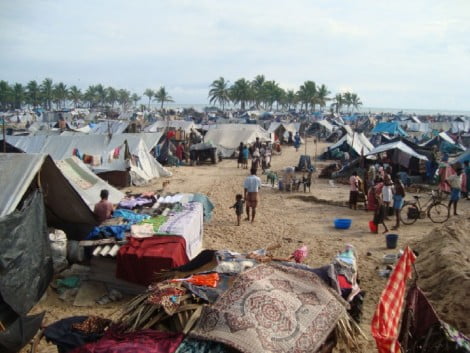

Justice may finally be coming to the victims of a mass atrocity that took place in Sri Lanka in the spring of 2009.
An estimated 40,000 ethnic Tamils were slaughtered in the concluding weeks of a Sri Lanka’s long civil war. Tamil civilians, along with the last remnants of the Tamil Tiger militia, were cornered into a small patch of beach about the size of Central Park in New York City. They were surrounded by the Sri Lankan military, which called this patch of land a “no-fire zone.” Just the opposite was true. Stories in the press and reports from reputable research institutions and the United Nations provide evidence that the Sri Lankan military made no attempt to distinguish between civilian and combatant while they pummeled the area with artillery. What resulted was a bloodbath that lasted several weeks.
From the International Crisis Group
The intentional shelling of civilians. Starting in late January, the government and security forces encouraged hundreds of thousands of civilians to move into ever smaller government-declared No Fire Zones (NFZs) and then subjected them to repeated and increasingly intense artillery and mortar barrages and other fire. This continued through May despite the government and security forces knowing the size and location of the civilian population and scale of civilian casualties.
The intentional shelling of hospitals. The security forces shelled hospitals and makeshift medical centres – many overflowing with the wounded and sick – on multiple occasions even though they knew of their precise locations and functions. During these incidents, medical staff, the United Nations, the International Committee of the Red Cross (ICRC) and others continually informed the government and security forces of the shelling, yet they continued to strike medical facilities through May forcing civilians to abandon them.
The intentional shelling of humanitarian operations. Despite knowing the exact location of humanitarian operations and food distribution points, the security forces repeatedly shelled these areas, which were crowded with humanitarian workers, vehicles and supplies, and civilians. Many were killed or wounded trying to deliver or receive basic humanitarian assistance, including women, children and infants.
This was the most horrific mass killing since Darfur, but it has received relatively little international attention. The Security Council failed to act, and the Human Rights Council was hobbled on this situation for years because of objections by key member states.
That may be about to change. Yesterday, the UN Human Rights Council approved an official inquiry into alleged war crimes in Sri Lanka. By a vote of 23-12 (with 12 abstentions) the Council agreed to a proposal from the High Commissioner of Human Rights Navi Pillay to dispatch a team of experts to investigate the alleged crimes.
This may provide the first clear path toward accountability and justice for the victims of this horrific slaughter. What often happens in investigations like this is that the report conclusions recommend that the situation be referred to the International Criminal Court, so that the perpetrators may be brought to justice. This would require an act of the Security Council, and this report provides a neutral set of facts upon which the Security Council can base its decision.
It could be a heavy lift to get the Security Council to agree to an ICC referral to Sri Lanka. Still, given the reluctance of the Sri Lankan authorities to investigate their own, if justice is to be served at all the ICC is probably the most likely venue. That means the Security Council must heed the recommendations of the Human Rights Council’s inquiry.
Image credit: IDP settlement near Putumattalan Hospital in second No Fire Zone, March 2009/UN
